Reserve Bank of Australia Annual Report – 2017 Banking and Payment Services
The Reserve Bank provides banking and payment services that underpin the efficient and stable functioning of the Australian financial system. The Bank is currently engaged in projects to renovate and strengthen its banking and settlement capabilities and introduce new infrastructure to support real-time payments by households and businesses on a 24/7 basis. This will enable the Bank to continue to meet the banking and payment needs of its government and agency customers and, in turn, the Australian public.
Banking
The Reserve Bank's banking services comprise two broad components: core and transactional banking services. Both are provided with the objective of delivering secure and efficient arrangements to meet the banking and payment needs of the Australian Government and its agencies. In addition, the Bank provides banking and registry services to a number of overseas central banks and official institutions.
Core banking services are provided to the Department of Finance and the Australian Office of Financial Management (AOFM). These services derive directly from the Reserve Bank's role as Australia's central bank and require the Bank to manage the consolidation of Australian Government agency account balances – irrespective of which financial institution each agency banks with – into the government's Official Public Account (OPA) at the Bank on a daily basis. This involves ‘sweeping’ balances from agency accounts at transactional banks at the end of each business day and returning only those balances required to meet agencies' day-to-day payment obligations the following morning. Any receipts collected by an agency on behalf of the Commonwealth are retained in the OPA. During 2016/17, the Bank assisted the Department of Finance to ensure financial institutions meet the Commonwealth's consolidation requirements, including the transfer of receipts to the OPA and in the required timeframes.
The Reserve Bank also provides the government with a term deposit facility for investment of its excess cash reserves, as well as a limited short-term overdraft facility to cater for occasions when there is unexpected demand for government cash balances. The overdraft facility was not accessed during 2016/17.
While the Reserve Bank manages the consolidation of the government's accounts, the AOFM has responsibility for ensuring there are sufficient cash balances in the OPA to meet the government's day-to-day spending commitments and for investing excess funds in approved investments, including term deposits with the Bank.
The Reserve Bank's transactional banking services are associated with more traditional banking and payment-related activities. Principal among these are services for making payments from government agencies to recipients' accounts. The Bank processed around 322 million domestic and 1.1 million international payments, totalling $517 billion and $10.8 billion respectively, for government agencies in 2016/17. Most of these were for the Department of Human Services and were made via direct entry. The Australian Government also makes payments by the real-time gross settlement (RTGS) system, cheque, BPAY and prepaid cards. Cheque volumes halved this year following Medicare's decision to stop offering cheques as a payment option and now comprise less than 1 per cent of agency payments. Over recent years, agencies' use of cheques has been declining more rapidly than that of the wider community, with agency cheques now making up 3 per cent of total cheques drawn compared with 5 per cent five years ago.
In addition to payments, the Reserve Bank provides government agency customers such as the Australian Tax Office with access to a number of services through which they can collect monies owed from both domestic and international payers. These include direct entry, RTGS, BPAY, cheque, eftpos, cash and card-based services via the internet and phone. The Reserve Bank processed 34 million collections-related transactions for the Australian Government in 2016/17, amounting to $468 billion. Reflecting industry trends, over-the-counter cash and cheque collections have declined significantly over the past five years. Agencies are also actively encouraging customers to use lower cost electronic payment options, in particular those that are more likely to be delivered error free and so avoid the need for costly back-office reconciliation.
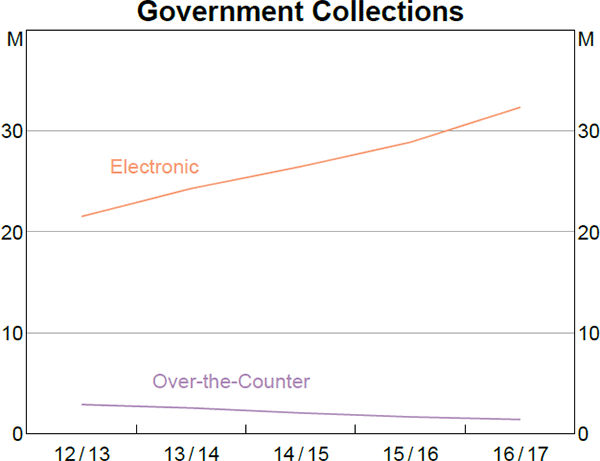
The provision of transactional banking services is consistent with the Reserve Bank's responsibilities under the Reserve Bank Act 1959, which requires the Bank to provide these services to the Australian Government if so required. A key difference between the Bank's core and transactional banking services is that the latter are offered in line with the Australian Government's competitive neutrality guidelines. To deliver the services, the Bank competes with commercial financial institutions, in many instances bidding for business at tenders conducted by the agencies themselves. The Bank must also cost and price the services separately from its other activities, including core banking services, and meet a prescribed minimum rate of return. Some 90 government agencies are transactional banking customers of the Bank.
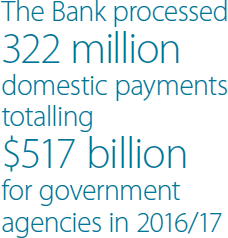
Pro forma business accounts for transactional banking are provided on page 125 of this report.
The Reserve Bank works closely with its transactional banking customers, the Australian Government and the payments industry more broadly to ensure that its customers have access to services that meet their needs and those of the public. For some services, the Bank combines its specialist knowledge of the government sector with specific services and products from commercial providers to meet the government's banking needs. In 2016/17, the Bank made enhancements to its prepaid card product and explored new options for collecting monies owed from international payers. The Bank will continue to make use of combined service arrangements with commercial providers as the government's banking needs evolve.

Former Assistant Governor (Financial System) Malcolm Edey addresses the Australian Financial Review Retail Summit, September 2016
Registry services are also provided by the Reserve Bank to supranational organisations issuing Australian dollar-denominated securities. Eight organisations currently use these services, with this number remaining relatively steady over recent years.
In common with other financial institutions, the Reserve Bank has been undertaking a significant program of work to upgrade its banking systems, moving them to a more modern programming language and architecture, and re-engineering a number of related business processes. Further milestones in the program were achieved during 2016/17. In particular, an upgraded capability was implemented in May 2017 to process revenue collected on behalf of government agency customers, and the first of two releases was completed in November 2016 to enable processing of direct entry payments through the new banking system. The Bank also engaged a third-party provider to upgrade the Bank's system for maintaining customers' accounts. The extensive process to select a suitable provider reflected the importance of the customer account maintenance system to the Bank's banking service. Allowing for the extended process, the system is scheduled to be operational in 2019.
During 2016/17, the Reserve Bank also continued its contribution to developing the payments industry's New Payments Platform (NPP), which will enable payments to be exchanged on a 24/7 basis in near real time together with more complete remittance information. As part of this contribution, work is under way to build, test and implement a system to process government-related transactions across the new platform. The Bank expects to make NPP services available to its agency customers from the payments industry's scheduled start of operations around the end of 2017. The Bank is working closely with government agencies to ensure they can take full advantage of the new payment capabilities over the medium term. Further information on the NPP is available below in the section on Settlement Services.
After-tax earnings from the Reserve Bank's transactional banking services were $3.4 million in 2016/17, $2.6 million lower than in the previous year. The fall was due largely to higher costs associated with systems development and service improvements. This was tempered slightly by increased revenue from transactions through the Bank's online collection services.
Settlement Services
The Reserve Bank owns and operates Australia's high-value settlement system – the Reserve Bank Information and Transfer System (RITS). RITS provides irrevocable settlement of high-value payment obligations across Exchange Settlement Accounts (ESAs) held at the Bank and is an integral part of Australia's financial system infrastructure. By providing a mechanism for RTGS, RITS eliminates the settlement risk that would otherwise arise between participants in high-value payments clearing and securities settlement systems. RITS also provides deferred net settlement services for low-value retail payments systems, equity settlements and settlement of property-related transactions.
Banks and other authorised deposit-taking institutions with aggregate values of 0.25 per cent or more of RTGS settlements in RITS must use their own ESA to settle their obligations. ESAs are also mandatory for all Australian-licensed central counterparties that are determined to be systemically important by the Reserve Bank. Other institutions providing third-party payment services with a need to settle interbank obligations may also apply for an ESA.
At the end of 2016/17, 55 RITS members were using their own ESA to settle their payment obligations. Foreign bank subsidiaries and branches accounted for around two-thirds of these active ESA holders.
An additional 38 members held an ESA, but chose to use another ESA holder to settle their RTGS transactions. A further 71 institutions were members of RITS to be eligible to participate in the Reserve Bank's open market operations, but did not hold an ESA.
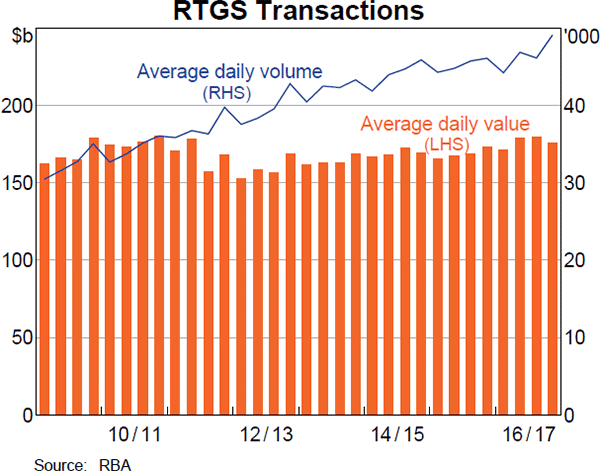
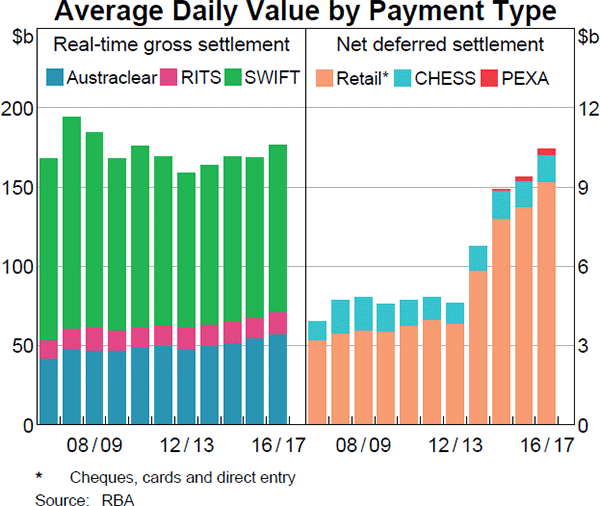
Transactions submitted to RITS are predominantly settled on an RTGS basis. RTGS is used for settling high-value customer, corporate and institutional payments, wholesale debt securities transactions and the Australian dollar leg of foreign exchange trades. On average, 47,000 RTGS transactions, worth $176 billion, were settled in RITS each day in 2016/17.
RITS is also used to settle payments on a deferred basis, after netting offsetting obligations between participants. Although net deferred settlement potentially involves some settlement risk, it allows for more efficient use of liquidity for high-volume and low-value payment types. Net deferred settlement occurs for retail payments (cheque, card, and direct entry) and some asset transactions (equities and some property-related transactions).
Settlement obligations arising from retail payments via cheque and some cards are settled the next business day in RITS at around 9.00 am. Settlement obligations from domestic MasterCard transactions are usually settled shortly after 7.30 am the next business day. Most settlement obligations arising from direct entry payments settle on a multilateral net basis at one of five designated settlement times on the day of exchange. During 2016/17, the aggregate average daily value of these retail payments settlements was $9.2 billion.
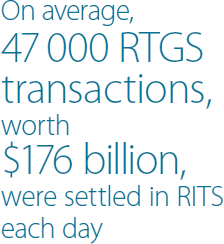
RITS also completes the interbank settlement of some asset-related transactions on a net deferred basis. The Clearing House Electronic Sub-register System (CHESS) batch, which provides for the daily settlement of payments arising from equity market transactions, averaged $1.0 billion per day in 2016/17. PEXA batches, which settle interbank obligations arising from electronic property transactions processed by Property Exchange Australia Limited, averaged $210 million per day in 2016/17.
The introduction of the NPP in 2017/18 will represent a major addition to Australia's payments system infrastructure. The NPP is designed to meet several strategic objectives for the Australian payments system, including: enabling users to make real-time retail payments; allowing more complete remittance information to be sent with payments; providing the ability to make payments in a relatively simple way; and facilitating sending and receiving payments outside normal business hours. It is an important collaborative effort by the payments industry, supported by the Reserve Bank, to allow financial institutions to send and receive timely payments on a 24/7 basis.
The Reserve Bank has developed the RITS Fast Settlement Service (FSS) to settle NPP payments individually in real time across ESAs. This will enable financial institutions to provide customers with immediate funds availability without incurring credit risk. The FSS has been designed for high performance and availability, and its launch will mark a significant milestone for the Australian payments industry. As with RITS, the Bank will seek to recover its costs of operating the FSS over time from transaction fees.

RITS is a systemically important part of the Australian financial system and, as such, is designed to be a highly resilient system, with critical infrastructure duplicated in two geographically separate sites. RITS is regularly benchmarked against international standards, including an annual assessment by the Reserve Bank against the Principles for Financial Market Infrastructures (PFMI) set by the Committee on Payments and Market Infrastructures (CPMI) and the International Organization of Securities Commissions (IOSCO). The May 2017 PFMI assessment concluded that RITS adhered to all the relevant principles, and recognised the Bank's work to address recommendations following the previous assessment. This work included the implementation of additional processes to detect, prevent and, if necessary, recover from operational incidents including cyber-related incidents. Cyber-risk management arrangements for RITS have also been reviewed in light of guidance on cyber resilience issued by the CPMI and IOSCO in June 2016.
The Reserve Bank offers accounts to other central banks and official institutions overseas to allow for settlement of certain Australian dollar payments, and provides safe custody services to these overseas agencies. The face value of securities held in custody by the Bank in this capacity was around $73 billion at the end of 2016/17. The Bank also provides settlement services for banknote lodgements and withdrawals by commercial banks.